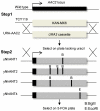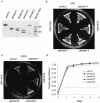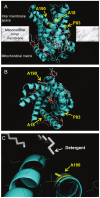Functional expression of human adenine nucleotide translocase 4 in Saccharomyces cerevisiae
- PMID: 21532989
- PMCID: PMC3080916
- DOI: 10.1371/journal.pone.0019250
Functional expression of human adenine nucleotide translocase 4 in Saccharomyces cerevisiae
Abstract
The adenine nucleotide translocase (ANT) mediates the exchange of ADP and ATP across the inner mitochondrial membrane. The human genome encodes multiple ANT isoforms that are expressed in a tissue-specific manner. Recently a novel germ cell-specific member of the ANT family, ANT4 (SLC25A31) was identified. Although it is known that targeted depletion of ANT4 in mice resulted in male infertility, the functional biochemical differences between ANT4 and other somatic ANT isoforms remain undetermined. To gain insight into ANT4, we expressed human ANT4 (hANT4) in yeast mitochondria. Unlike the somatic ANT proteins, expression of hANT4 failed to complement an AAC-deficient yeast strain for growth on media requiring mitochondrial respiration. Moreover, overexpression of hANT4 from a multi-copy plasmid interfered with optimal yeast growth. However, mutation of specific amino acids of hANT4 improved yeast mitochondrial expression and supported growth of the AAC-deficient yeast on non-fermentable carbon sources. The mutations affected amino acids predicted to interact with phospholipids, suggesting the importance of lipid interactions for function of this protein. Each mutant hANT4 and the somatic hANTs exhibited similar ADP/ATP exchange kinetics. These data define common and distinct biochemical characteristics of ANT4 in comparison to ANT1, 2 and 3 providing a basis for study of its unique adaptation to germ cells.
Conflict of interest statement
Figures








Similar articles
-
Identification of adenine nucleotide translocase 4 inhibitors by molecular docking.J Mol Graph Model. 2013 Sep;45:173-9. doi: 10.1016/j.jmgm.2013.08.016. Epub 2013 Sep 4. J Mol Graph Model. 2013. PMID: 24056384 Free PMC article.
-
Evolutionarily conserved mammalian adenine nucleotide translocase 4 is essential for spermatogenesis.J Biol Chem. 2007 Oct 5;282(40):29658-66. doi: 10.1074/jbc.M704386200. Epub 2007 Aug 6. J Biol Chem. 2007. PMID: 17681941
-
Conserved properties of hydrogenosomal and mitochondrial ADP/ATP carriers: a common origin for both organelles.EMBO J. 2002 Feb 15;21(4):572-9. doi: 10.1093/emboj/21.4.572. EMBO J. 2002. PMID: 11847105 Free PMC article.
-
The ADP and ATP transport in mitochondria and its carrier.Biochim Biophys Acta. 2008 Oct;1778(10):1978-2021. doi: 10.1016/j.bbamem.2008.04.011. Epub 2008 May 2. Biochim Biophys Acta. 2008. PMID: 18510943 Review.
-
Chemical, immunological, enzymatic, and genetic approaches to studying the arrangement of the peptide chain of the ADP/ATP carrier in the mitochondrial membrane.J Bioenerg Biomembr. 1993 Oct;25(5):459-72. doi: 10.1007/BF01108403. J Bioenerg Biomembr. 1993. PMID: 8132486 Review.
Cited by
-
Learning from Yeast about Mitochondrial Carriers.Microorganisms. 2021 Sep 28;9(10):2044. doi: 10.3390/microorganisms9102044. Microorganisms. 2021. PMID: 34683364 Free PMC article. Review.
-
Two adenine nucleotide translocase paralogues involved in cell proliferation and spermatogenesis in the silkworm Bombyx mori.PLoS One. 2015 Mar 5;10(3):e0119429. doi: 10.1371/journal.pone.0119429. eCollection 2015. PLoS One. 2015. PMID: 25742135 Free PMC article.
-
Identification of adenine nucleotide translocase 4 inhibitors by molecular docking.J Mol Graph Model. 2013 Sep;45:173-9. doi: 10.1016/j.jmgm.2013.08.016. Epub 2013 Sep 4. J Mol Graph Model. 2013. PMID: 24056384 Free PMC article.
-
Human Adenine Nucleotide Translocase (ANT) Modulators Identified by High-Throughput Screening of Transgenic Yeast.J Biomol Screen. 2016 Apr;21(4):381-90. doi: 10.1177/1087057115624637. Epub 2016 Jan 8. J Biomol Screen. 2016. PMID: 26746582 Free PMC article.
-
GeneGini: Assessment via the Gini Coefficient of Reference "Housekeeping" Genes and Diverse Human Transporter Expression Profiles.Cell Syst. 2018 Feb 28;6(2):230-244.e1. doi: 10.1016/j.cels.2018.01.003. Epub 2018 Feb 7. Cell Syst. 2018. PMID: 29428416 Free PMC article.
References
-
- Trezeguet V, Pelosi L, Lauquin GJ, Brandolin G. The mitochondrial ADP/ATP carrier:functional and structural studies in the route of elucidating pathophysiological aspects. J Bioenerg Biomembr. 2008;40:435–443. - PubMed
-
- Rodić N, Oka M, Hamazaki T, Murawski M, Jorgensen M, et al. DNA methylation is required for silencing of ant4, an adenine nucleotide translocase selectively expressed in mouse embryonic stem cells and germ cells. Stem Cells. 2005;23:1314–1323. - PubMed
-
- Dolce V, Scarcia P, Iacopetta D, Palmieri F. A fourth ADP/ATP carrier isoform in man:identification, bacterial expression, functional characterization and tissue distribution. FEBS Lett. 2005;579:633–637. - PubMed
-
- Brower JV, Rodic N, Seki T, Jorgensen M, Fliess N, et al. Evolutionarily conserved mammalian adenine nucleotide translocase 4 is essential for spermatogenesis. J Biol Chem. 2007;282:29658–29666. - PubMed
Publication types
MeSH terms
Substances
Grants and funding
LinkOut - more resources
Full Text Sources
Research Materials

